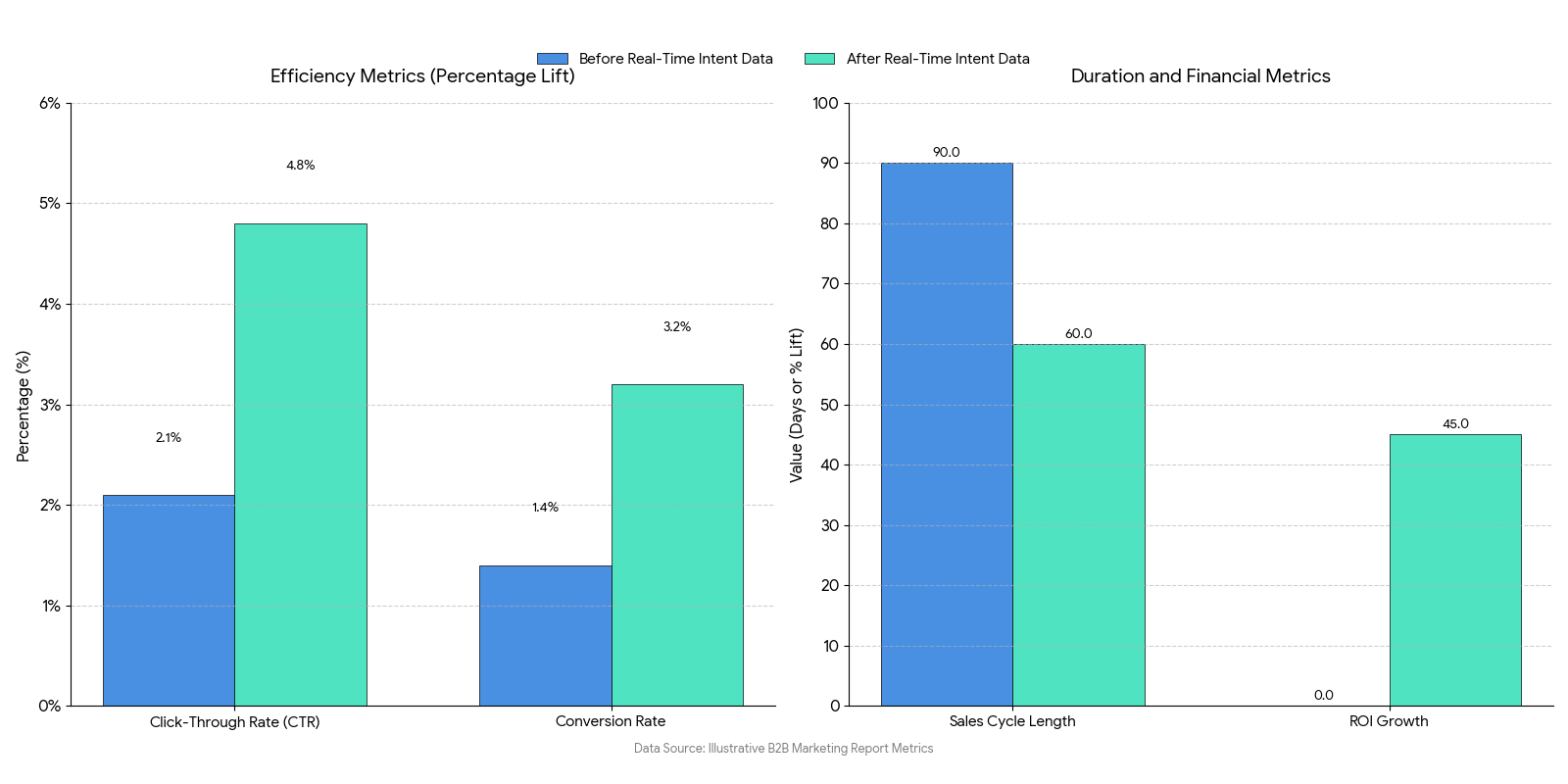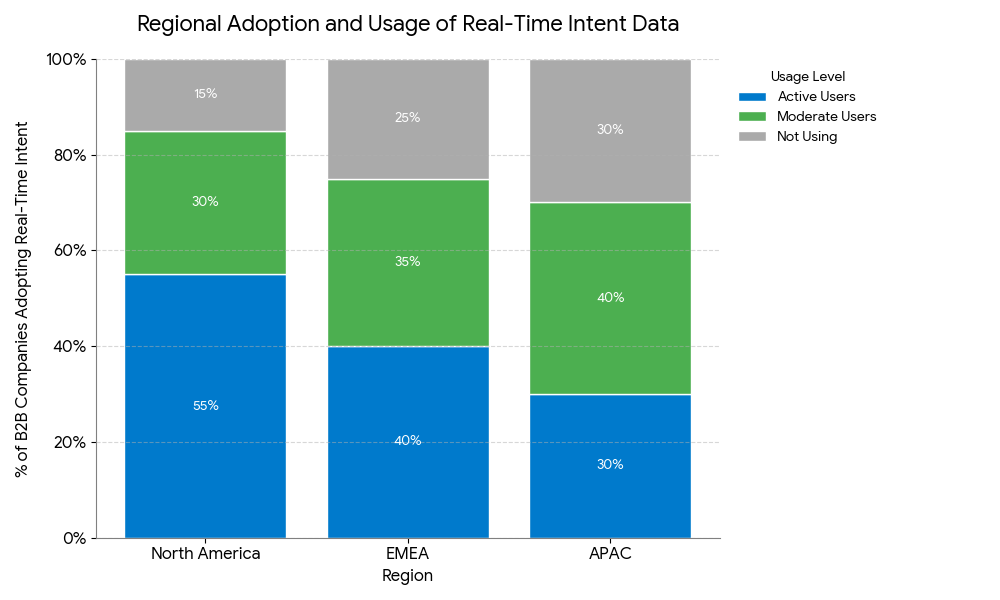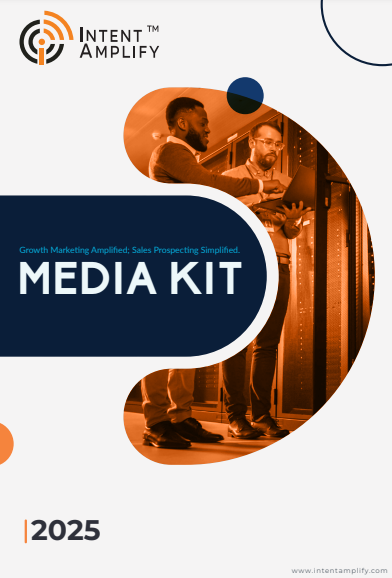
Why Real-Time Intent Data Matters for B2B Campaign Performance
- Last updated on: October 15, 2025
In B2B marketing, timing has become everything. Reaching the right audience no longer guarantees success. It reaches them at the right moment, does. That’s where Real-Time Intent Data transforms campaign performance. Unlike traditional insights that rely on past behavior, real-time intent reveals what buyers are actively researching right now. For marketers, this immediacy bridges the gap between awareness and action. It enables teams to deliver messages, content, and offers at the exact moment when intent peaks. In a world driven by speed and precision, Real-Time Intent Data helps B2B organizations move faster, engage smarter, and convert with greater efficiency.
Understanding Real-Time Intent Data in B2B Marketing
The Shift from Static to Dynamic Intent Signals
B2B intent data once meant analyzing patterns over weeks or months. Marketers studied reports of who downloaded whitepapers, visited landing pages, or engaged with ads. But those insights were already dated by the time they were activated. Real-Time Intent Data changed that approach completely.
Instead of waiting for aggregated data, modern systems capture and process live behavioral signals from multiple sources. These are search activity, social interactions, website visits, and engagement with third-party content. The result is a constantly updating view of buyer interest. Dynamic intent detection allows marketers to identify new opportunities the moment they surface, instead of acting after competitors have already made their move.
How Real-Time Intent Data Works
Real-Time Intent Data gathers behavioral signals across digital ecosystems. Each action, whether reading a product review, attending a webinar, or researching a keyword, creates a signal. These signals are captured by data partners, processed through AI models, and enriched with firmographic and technographic details.
This enriched data then feeds into CRMs, ABM platforms, and marketing automation tools. From there, teams can instantly trigger personalized campaigns or alerts for sales. Importantly, ethical sourcing and compliance with regulations like GDPR and CCPA ensure this data respects privacy standards.
When done right, Real-Time Intent Data delivers a living picture of market demand. It helps marketers prioritize efforts where interest is highest and align messaging with immediate buyer needs.
The Impact of Real-Time Intent Data on Campaign Performance
The data clearly demonstrates how real-time intent signals can improve both marketing efficiency and revenue outcomes:
Efficiency Metrics (Percentage Lift)
| Metric | Before Real-Time Intent Data | After Real-Time Intent Data | Improvement |
| Click-Through Rate (CTR) | 2.1% | 4.8% | Increase |
| Conversion Rate | 1.4% | 3.2% | Increase |
Targeting prospects actively researching a solution leads to a dramatic increase in both engagement (CTR) and desired outcomes (Conversion Rate).
Duration and Financial Metrics
| Metric | Before Real-Time Intent Data | After Real-Time Intent Data | Improvement |
| Sales Cycle Length | 90 days | 60 days | Reduction |
| ROI Growth | Baseline | +45% | Lift |
By reaching high-intent buyers earlier in their journey, the average Sales Cycle Length is significantly reduced (30 fewer days), resulting in a substantial 45% increase in ROI Growth.
Improving Targeting Accuracy
Traditional targeting often feels like educated guessing. Marketers rely on static segments and predictive scoring to define audiences. But these approaches don’t always reflect what buyers care about today. Real-Time Intent Data corrects that gap by focusing on active demand.
For example, a B2B SaaS company running an ABM campaign might notice that several target accounts are suddenly researching “data governance solutions.” With that signal, they can immediately adjust messaging and budgets toward that topic. Meeting the buyer where their attention currently lies. This precision not only reduces wasted ad spend but also increases engagement quality, ensuring every impression and click serves a measurable purpose.
Enabling Dynamic Personalization
Static messaging no longer drives conversions. Real-Time Intent Data makes personalization truly dynamic. Instead of pre-scheduled campaigns, marketers can adapt creative assets, email copy, or ad placements based on real-time engagement trends.
Imagine an enterprise considering a cloud migration service. As their research intent rises, the marketing system automatically triggers tailored case studies or thought leadership content around migration security and ROI. When content matches the audience’s immediate intent, conversion rates rise sharply.
This capability is particularly powerful in Account-Based Marketing (ABM) programs, where timing and relevance decide success. Real-time insights allow marketers to engage decision-makers with precision, building trust faster and shortening sales cycles.
Measuring Engagement and Conversion Lift
Real-Time Intent Data also improves campaign measurement. Instead of waiting weeks for post-campaign reports, marketers can view performance shifts as they happen. This allows rapid optimization. Whether adjusting bids, refining creative, or reallocating budgets.
Below is an example comparison between traditional campaigns and those powered by real-time intent activation.
Regional Adoption and Usage of Real-Time Intent Data
The clustered bar chart below clearly illustrates the varying stages of Intent Data maturity across global regions, with North America leading in active implementation.
- Active Users (Deep Blue) are B2B companies with fully integrated Real-Time Intent Data driving personalized campaigns and sales outreach.
- Moderate Users (Green) are companies running pilot programs or using intent data for general lead scoring and prioritization, but not yet fully integrated across all functions.
- Not Using (Gray) are companies yet to adopt the technology.
This data reflects the fact that North America has a more mature B2B technology ecosystem, while regions like EMEA and APAC are rapidly moving from the “Moderate” to the “Active” category as awareness and accessibility increase.
Operationalizing Real-Time Intent Data Across Teams
Aligning Marketing and Sales Efforts
The power of Real-Time Intent Data expands beyond marketing alone. When sales teams gain access to live insights, they can focus on accounts that show active buying behavior. For example, if an account’s intent score spikes around “enterprise cybersecurity solutions,” sales representatives can prioritize outreach within that window of opportunity.
This alignment transforms collaboration. Instead of debating which leads are worth pursuing, both teams work from a shared source of truth. It eliminates guesswork, sharpens pipeline focus, and accelerates deal progression. Sales development representatives (SDRs) can personalize outreach, mentioning recent content the prospect engaged with, making every conversation more contextual and effective.
Integrating with Existing Tech Stack
Integrating Real-Time Intent Data into existing tools is crucial for scale. Leading platforms like HubSpot, Marketo, Salesforce, and Demandbase now support seamless data syncs. When integrated properly, marketers can automate workflows that trigger outreach or personalization instantly.
For instance, if a target account starts reading cybersecurity reports across multiple publishers, an automated campaign might immediately deploy a personalized ad or send the account a relevant email sequence. This automated precision ensures no opportunity is missed while reducing manual intervention.
Ultimately, the strength of Real-Time Intent Data lies not only in what it reveals, but how efficiently it moves across systems to drive immediate action.
Challenges and Best Practices for Using Real-Time Intent Data
Avoiding Data Overload
One challenge marketers face is volume. With thousands of data points streaming in, distinguishing meaningful intent from background noise becomes critical. Teams must focus on defining relevance filters. prioritizing signals that align with their target industry, company size, and buying stage. Without this discipline, real-time data can overwhelm rather than empower.
Ensuring Data Accuracy and Compliance
Accuracy determines trust. Working with verified intent providers ensures signals come from credible sources. Compliance with global regulations like GDPR and CCPA must also be a priority. The best vendors emphasize transparency and consent-based data collection. This not only mitigates risk but also builds confidence among enterprise buyers who expect ethical marketing practices.
Building a Continuous Feedback Loop
Real-Time Intent Data is most effective when continuously refined. Campaigns should include A/B testing to evaluate which triggers, messages, and offers generate the best results. Insights from one cycle can then inform the next, creating an ongoing optimization loop. Over time, this feedback mechanism strengthens performance predictability and improves marketing ROI.
The Future of B2B Marketing with Real-Time Intent Data
The evolution of intent intelligence is only beginning. As predictive AI and automation continue to advance, B2B marketers will soon operate in environments where campaign orchestration happens in near real-time. Machine learning models will predict when a prospect’s intent is about to rise. It allows proactive engagement instead of reactive marketing.
In this future, Real-Time Intent Data becomes the foundation of every demand engine. It will drive adaptive content, programmatic precision, and smarter revenue operations. Organizations that embrace this shift will move ahead of competitors still relying on delayed insights. The ability to act at the moment of intent will separate agile market leaders from those struggling to catch up.
Conclusion
Real-Time Intent Data represents the next frontier in B2B marketing intelligence. It empowers brands to act at the speed of buyer behavior. It bridges the gap between intent discovery and engagement. With accurate signals, dynamic personalization, and tighter marketing-sales alignment, it drives stronger campaign performance and sustainable growth.
As competition intensifies, the difference between success and stagnation will come down to timing. Organizations that adapt to real-time marketing models will not only understand demand faster but also convert it before anyone else. The future belongs to teams that treat Real-Time Intent Data as a core growth driver, not just another marketing metric.
FAQs
What makes Real-Time Intent Data different from regular intent data?
Regular intent data is aggregated and updated periodically, often weekly or monthly. Real-Time Intent Data captures live signals as they occur, offering immediate insights into buyer behavior and interest.
How can B2B marketers start using Real-Time Intent Data effectively?
Begin with a clear definition of target segments and integrate a trusted intent provider with your CRM or ABM platform. Start small, analyze performance impact, and scale gradually.
What platforms or tools support Real-Time Intent Data integration?
Platforms like HubSpot, Salesforce, Marketo, Demandbase, and Bombora support real-time integrations that allow marketers to activate campaigns based on live data streams.
Does using Real-Time Intent Data guarantee higher ROI?
While no data tool guarantees success, Real-Time Intent Data significantly improves precision and timing. This leads to higher engagement, faster conversions, and better ROI when used strategically.
How often should marketers refresh their intent data?
With real-time signals, updates occur continuously. However, marketers should routinely audit integrations, campaign triggers, and filters every few months to maintain accuracy and alignment.





